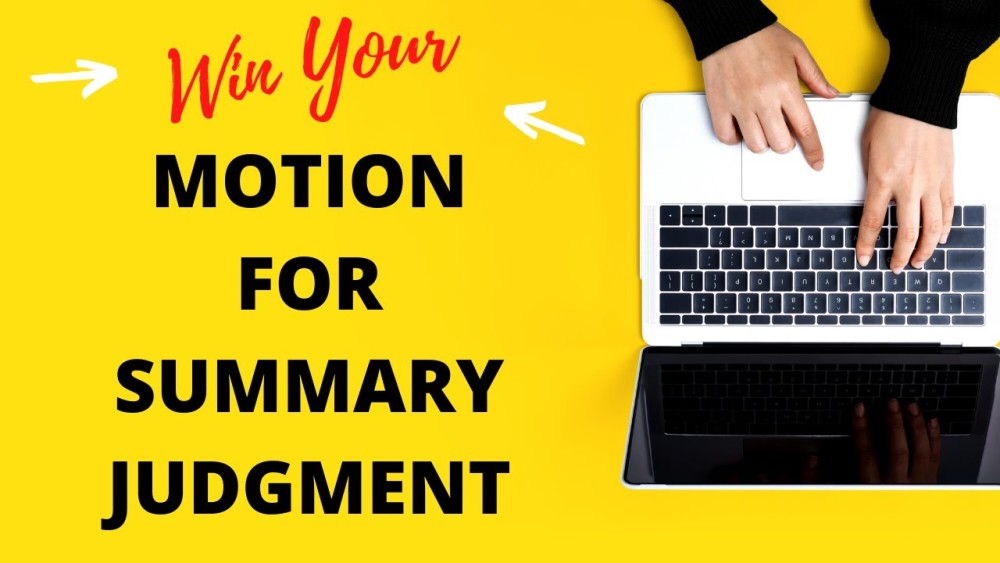Get Your Legal Documents Now!
Whether you are dealing with a complex family matter, facing criminal charges, or navigating the intricacies of business law, our mission is to provide you with comprehensive, compassionate, and expert legal guidance.

Learn effective strategies for responding to a motion for summary judgment. Discover how plaintiffs and defendants can challenge and defeat an MSJ with evidence, law, and timing.
How to Respond to a Motion for Summary Judgment: Strategies for Opposing Counsel
Introduction
A motion for summary judgment (MSJ) can be a powerful move by your opponent to win a case—or parts of it—without a trial. But a well-prepared and strategic response can stop that motion in its tracks.
Whether you’re a plaintiff or a defendant, understanding how to respond effectively is essential. Courts don’t just grant summary judgment because it was filed—they require convincing evidence and legal support. If you know how to challenge the motion, you can preserve your claims, highlight disputed facts, and protect your path to trial.
In this article, we’ll explore the key strategies for opposing a motion for summary judgment, including what to file, what evidence to gather, and how to position your arguments. For court-ready, professional legal document drafting, Legal Husk offers litigation services at legalhusk.com and legalhusk.com/services/civil-litigation.
Understanding the Purpose of a Summary Judgment Motion
A motion for summary judgment asks the court to rule before trial, asserting that there is no genuine dispute of material fact and the moving party is entitled to judgment as a matter of law.
If granted, the judge can:
As the opposing party, your job is to show the court that disputed facts remain, or that the legal basis for the motion is flawed.
1. Know the Rules and Deadlines
Responding to a summary judgment motion is governed by strict court rules:
Deadlines
Formatting Requirements
Check your court’s scheduling order and local rules before you begin.
2. Focus on Disputed Material Facts
Your strongest argument is often simple and factual: show that there’s a genuine dispute of material fact that must be resolved by a jury.
What to Do:
Best Practices:
Types of Evidence to Use:
If your facts conflict with theirs, the court must deny summary judgment.
3. Challenge the Legal Argument
Sometimes the facts aren’t the issue—the law is. A motion can fail if it misstates legal standards or ignores precedent.
How to Respond:
Tip:
Tailor your legal arguments to the jurisdiction’s controlling precedent and use analogous case outcomes to bolster your position.
4. File Supporting Documents and Exhibits
You can’t win on argument alone. Evidence must support your response.
What to Include:
Ensure all exhibits are:
5. Use Procedural Tools If Needed
Rule 56(d) Motion (Federal Court)
If discovery is incomplete or you need more time, file a Rule 56(d) motion.
This asks the court to:
Grounds for 56(d):
This tactic works best when the court sees genuine need, not delay tactics.
6. Consider Partial Concessions
You don’t always have to oppose every claim. In some cases, it’s strategic to:
Doing so can preserve credibility and focus your response where it matters most.
7. Prepare for the Hearing
Many courts hold oral arguments on summary judgment motions. Prepare to:
Use the hearing to emphasize why the case must go to a jury.
8. Use the Response to Strengthen Your Trial Position
Even if summary judgment is granted in part or denied entirely, your response brief can:
Think of your response as a trial prep tool as well as a procedural defense.
Common Mistakes to Avoid
A single misstep could lead to judgment being entered against you.
How Legal Husk Can Help You Respond
At Legal Husk, we specialize in preparing court-ready documents that make a strong, compliant, and persuasive case against summary judgment.
Our Civil Litigation Services Include:
You can purchase our legal services online at:
Whether you're facing a deadline or building your litigation plan, Legal Husk is your partner in opposing summary judgment effectively.
Final Thoughts
Responding to a motion for summary judgment is your opportunity to protect your case and keep it alive. A clear, well-supported, and strategic response can expose factual disputes, challenge flawed arguments, and position you for trial.
📩 Need help drafting your opposition to a motion for summary judgment? Visit Legal Husk to purchase expertly prepared legal documents and litigation support services that give you the upper hand.
Whether you are dealing with a complex family matter, facing criminal charges, or navigating the intricacies of business law, our mission is to provide you with comprehensive, compassionate, and expert legal guidance.
Comments